Are you an affiliate marketer struggling to increase your earnings per click but not sure how to get started?
Earnings per Click (EPC) is a key metric in online marketing and advertising that measures the revenue earned for each click on an ad or link. It’s a vital indicator of a campaign’s profitability and overall effectiveness.
It can help determine whether or not a product is worth your time, money, and energy. And once you’ve learned how to increase your EPC, you can expect to drive larger profits from affiliate sales.
That’s why, in this post, we’re going to teach you:
And by the end of this article, you’ll know exactly how to make more money through affiliate marketing.
Before anything, though, let’s get clear on what EPC means and why it’s so important to track.
Let’s get started.
OptinMonster provides over 50 pre-built templates to help you make the right campaign for your affiliate product. We also offer many targeting rules and campaign triggers to ensure you’re showing the right message to the right people at the right time.
Click here to get started →
What Does EPC Mean in Affiliate Marketing?
Earnings per click (EPC) is an affiliate marketing term that refers to the average amount of money you earn each time someone clicks one of your affiliate links. EPC affiliate marketing is, typically, run through pay-per-click (PPC) ads.
But the EPC affiliate meaning is the most important metric for being successful at affiliate marketing.
That’s because it concretely indicates your earning potential.
And this is true whether you’re running an affiliate program or sharing links from affiliate partners.
Here’s why:
Though many new affiliate marketers aren’t aware of EPC, what it is, and how to calculate it (which we’ll cover shortly), they know another popular marketing term: “Cost per click” (CPC).
So they search for products that have the lowest CPC, run expensive pay-per-click ads to that affiliate link, and hope that they’ll make enough money back to cover their advertising costs.
Oh, and they’d also like to make a small profit.
But if you can accurately calculate EPC, then you don’t need to rely on hope.
You can make data-driven decisions with predictable success and even target other affiliate products with higher CPC.
Because once you know your EPC, then the CPC is actually irrelevant. In other words, so long as you are always earning more than you spend, you’ll be profitable.
Which is why we find it funny when people ask us, “What is a good EPC?”
The answer is simple: your earnings per click are good any time they’re higher than your cost per click.
Because then you’re making money. Period.
Once you understand this concept, you’ll be on your way to increasing profits from your affiliate marketing strategy.
How is EPC Calculated?
Your earnings per click calculation is easy:
EPC = the total amount of commissions you earn divided by the number of clicks your affiliate links had.
That’s it!
So let’s say you were running ads for an affiliate product. Your total profit from the campaign was $100, and all of that revenue came from 50 clicks on your affiliate link.
That would mean your EPC is calculated by $100 (your profit) divided by 50 (your total clicks) for a total of $2.
Plus, many affiliate marketing sites have this information on hand for affiliate marketers. They’ll calculate the average affiliate EPC of their products for you:
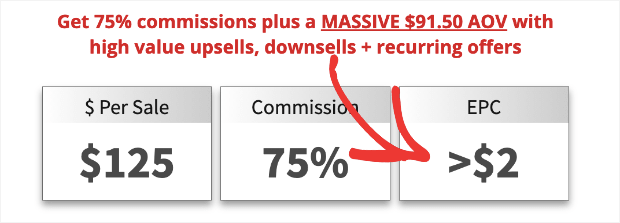
This data is sometimes called “network EPC” because it comes from the affiliate program’s network of partners to create the average.
These earning per click affiliate programs give you this information to help you choose your affiliate products more wisely.
Now we can already tell what you’re thinking:
If you know your earnings per click and your cost per click, why doesn’t everyone just choose products with a higher EPC than CPC and pump ads to that affiliate link?
In the end, you’re bound to make more than you spend, right?
Well, yes and no.
The problem is that these are average earnings per click, meaning they aren’t the same for all affiliate partners. One person may link to a product with an EPC of $3.00 and another with an EPC of $1.00.
So you get the average of an EPC at $2.00.
But your marketing strategy may not yield that exact result.
This is why blindly choosing a product based on the highest EPC affiliate program isn’t as rock-solid a strategy as you may think.
The only way to know your EPC on affiliate links will be to test it yourself.
And that’s exactly what we’ll cover in the rest of this article. Because we’re going to teach you how to boost your EPC to drive more affiliate sales FAST.
Let’s turn our attention to 7 ways to improve your EPC.
How to Increase Earnings Per Click
In many cases, affiliate marketers run paid ads to their affiliate products.
But the following 7 strategies are ways to increase your profits without relying on paid ads at all.
That’s because, for many of these tips, we’ll be using OptinMonster:
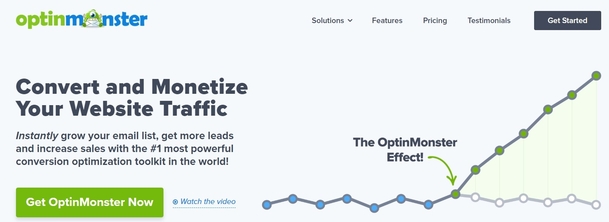
OptinMonster is hands down the best way to create a more profitable affiliate marketing strategy and increase your earnings per click. It allows you to make highly effective “optin campaigns” like popups, floating bars, fullscreen welcome mats, and more.
These optin campaigns are super easy to create and require zero coding or “tech” skills to get started.
Everything starts by selecting the right template for the type of campaign you want to build:
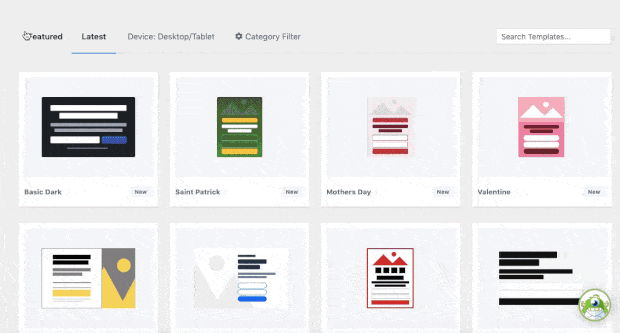
These templates save you time, energy, and headaches in the campaign creation process. They come with everything you need to boost affiliate sales out-of-the-box.
Plus, they look great across all devices: mobile, desktop, and tablets.
Once you’ve chosen the right campaign, you can easily make modifications to customize it to your brand and offer.
To change the text, for example, you can use OptinMonster’s inline editor:

This allows you to personalize your campaign’s messaging for higher conversion rates.
Want to add a new feature like images, videos, chatbots, and more? You can do so with a drag and a drop:
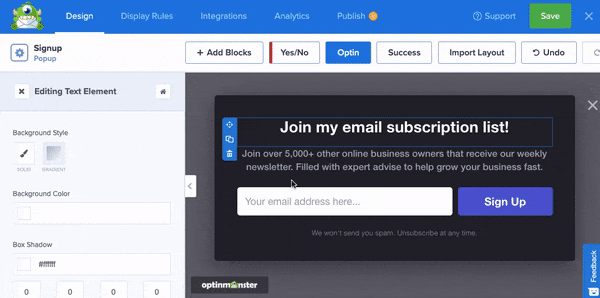
This makes it possible for anyone to create high-converting and professional-looking campaigns in a matter of minutes.
But once the campaign has been built, how do you show it to the right people to maximize affiliate sales?
You can use OptinMonster’s targeting rules and triggers.
These will ensure that your campaigns are shown to the right people, in the right places, and at just the right time in their customer journey.
A few of OptinMonster’s most popular rules include:
- Exit-Intent® Technology: Display a campaign, like a lightbox popup, as users are actively leaving your site to recapture abandoning visitors.
- OnSite Retargeting®: Show new campaigns to returning visitors to prevent “popup fatigue.”
- Geolocation Targeting: Create campaigns to appear to people based on where they’re physically located.
- Page-Level Targeting: Make your campaigns appear on specific posts or pages across your site.
These targeting rules can help you show the right affiliate products to only the most relevant portion of your site’s traffic.
This increases your conversions, boosts your EPC, and doesn’t require any budget for expensive advertising.
Ready to see it in action for yourself? Click below to start your 100% risk-FREE OptinMonster account today:
Now let’s dive into our 7 tips for increasing EPC.
1. Re-engage Abandoning Visitors With Exit-Intent
First and foremost, you’ll want to create a targeted popup for your affiliate product to display across your site.
In many cases, we would suggest using OptinMonster’s Exit-Intent® Technology.
This is what the marketing agency, Top 6 Digital, did to boost their client’s affiliate sales.
Here’s how:
When someone was checking out a post on car seats, they’d see this campaign when they tried to leave the site:
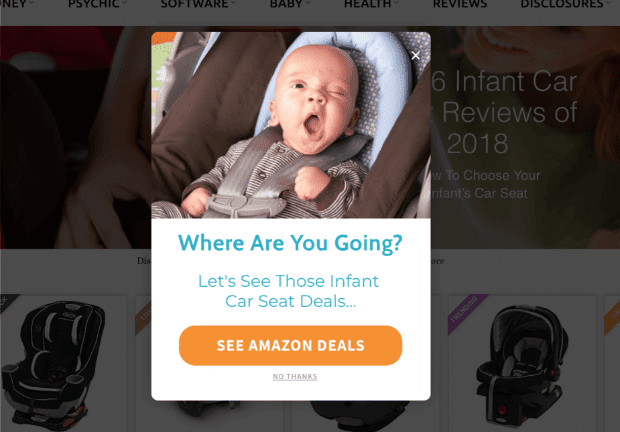
This grabbed the user’s attention and re-engaged them.
When a user clicked “See Amazon Deals,” it would redirect users to a product page with an affiliate link.
The result?
From this popup alone, 17.31% of their readers clicked through. Plus, they boosted affiliate sales by 30%.
But the best part is that they showed this popup to their site’s organic traffic. That means lower costs for paid ads, a higher total profit, and an increased EPC.
2. Share Affiliate Links With Popups on Your Site
For some affiliate marketers, exit-intent popups might not be enough. Does that mean you should ditch popup campaigns altogether?
Absolutely not.
Instead, you can create other targeted campaigns like timed popups on specific pages across your site.
That way, you can match your popup’s offer (the affiliate product) with the content of the page your audience is reading.
Imagine that your affiliate product is a pair of sunglasses. So you write a blog post and compare different types of sunglasses that would be most beneficial for your target audience.
When people begin reading the post (showing a high interest in the topic), you show them this popup after 10 seconds or so:

Since your audience is already reading your blog post on sunglasses, you know they’re a good candidate for this offer.
That means more clicks on your affiliate products. But since your cost-per-click (CPC) is now lower (because you aren’t running paid ads), your total EPC will be much higher.
How do you set up this targeting rule? This would be the combination of 2 rules:
- Time on page
- Page-level targeting
Both can be easily set up from OptinMonster’s Display Rules dashboard:

Targeting your affiliate product popup will go a long way to getting more affiliate sales with a higher EPC.
3. Create a Non-Intrusive Floating Bar
Some marketers don’t like the idea of using popups on their site. They worry that popups will harm the user experience (UX).
In most cases, this simply isn’t true. Online consumers don’t dislike popups; they dislike seeing the same popups over and over again.
This leads to something called “popup fatigue,” and it can train your site’s visitors to ignore the messaging on your popups.
That’s why it’s important to use a variety of campaign types to display your affiliate products. One that we recommend is a floating bar:

Floating bars are a totally non-intrusive way of giving your visitors information about your affiliate products.
It rests discretely at the top of the user’s page in a way that is impossible to ignore but doesn’t harm UX.
We still recommend targeting your floating bar by page, but it can work well for sitewide offers, too.
Regardless of where and when you choose to display the floating bar, this can be a great campaign for boosting your EPC and driving more affiliate sales.
4. Embed Affiliate Links in Your Blog Posts
You can drive tons of organic traffic by creating reliable, quality content on your site. The most popular method for doing this is by starting a blog.
By following SEO best practices, you can start ranking on search engines like Google to attract more visitors to your website.
Then you can add your affiliate links directly to the content to get more sales.
OptinMonster uses this technique to boost affiliate revenue from the blog:

Then we sometimes add coordinated popups to get more attention to that offer, as we discussed in our first tip.
That way, your readers can click the affiliate link in your content, AND they’ll see the targeted fullscreen popup on the content page.
That doubles your chances of getting the sale.
This is a great way to increase your EPC. Plus, because you’re relying on organic traffic from your content strategy, your CPC is effectively zero.
Any purchases made from your content or the affiliate product popup will yield 100% of the commission (minus the time spent creating the content).
We’ve written extensively on how to create a killer content strategy. But for affiliate links, try to use the following types of blog or vlog posts:
- Comparative articles
- Product reviews
- Product list
- Resource pages
But whenever you add an affiliate link to your content, it’s sometimes useful to warn your readers.
WPBeginner is excellent at this.
They let users know that affiliate links are included but assure readers that they only promote products they actually use and love:
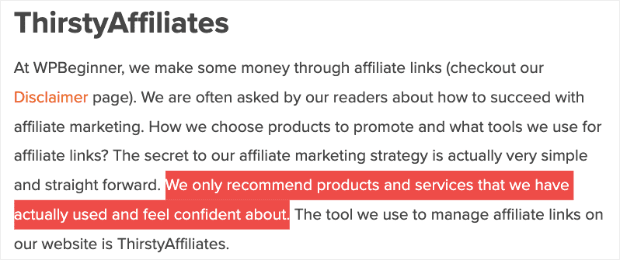
Your readers won’t care if you include affiliate links. However, they may care if it seems like you’re trying to trick them into a sale.
So be open and upfront about the fact that your article has an affiliate link, and your audience won’t so much as bat an eye if they see one.
5. Embed Affiliate Links in Your Email Series
Ok, we need to tread lightly here. Because adding affiliate links to email can go 1 of 2 ways:
- Super high profits
- Getting banned from your email service provider
It’s not hard to guess which outcome you should be aiming for. The difference between the two results is all in the approach.
Email service providers don’t like spam. It hurts their open rate percentages and, frankly, is just bad for their business.
So when they see affiliate marketers with huge email lists sending out campaigns loaded with affiliate links, they’ll step in and shut it down.
But that doesn’t mean you can’t add any affiliate links in your emails.
It just means you need to do it in a way that isn’t spammy.
You can do that by providing valuable content to your email list regularly. Then, add an email highlighting an affiliate product somewhere in your automated email series.
So your series may look something like this:
- Welcome email
- Content sharing
- Nurture the relationship
- Affiliate link email
- More content sharing
- More content sharing
- Nurture the relationship
- Affiliate link email
And so on. The exact email series will depend on you and your business. But the point remains the same: don’t spam your email list with tons of affiliate links every day.
One email service provider you may want to consider is Drip:

Drip is fantastic at creating email marketing campaigns. They have a drag and drop builder that lets you make stylish designs to capture your audience’s attention.
Plus, we have it on good authority that they allow affiliate links in your emails if used responsibly:
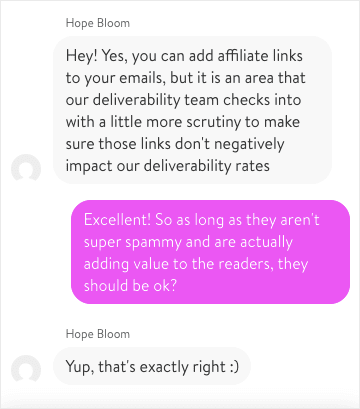
Other services with similar policies on affiliate links are Constant Contact and Brevo (formerly Sendinblue).
Regardless of the email service provider you go with, you should reach out to their marketing team. Get clarity on what their policies are with affiliate marketing and how you can avoid getting penalized.
After all, it would be a shame to go through all that work of building your email list only to have it shut down for spamming your customers.
But now for the big question: how do you grow your list with an engaged audience of qualified leads?
Growing your email list is OptinMonster’s specialty, and it’s the best tool on the market for doing so.
Just check out a few of these success stories that customers have shared with us in the past:
- Adam Enfroy Added 11,000+ Subscribers in 1 Year
- Crossrope Exploded Its List by 900%
- Cosmetic Packaging Grew Their Email List by 754%
You can see the same results with OptinMonster, too.
And once your list is full of an engaged audience, you can use this low-cost platform to drive more affiliate sales and maximize your EPC.
6. Test & Tweak Your Copy, Then Rinse & Repeat
Part of any good marketing strategy is A/B testing. Unfortunately, not enough marketers take the time to create solid A/B tests.
And they’re missing out big time.
If you’re adding affiliate links to your optin campaigns or in your emails, you absolutely need to A/B test.
Because the chances that you nailed your landing page or email copy on the first take are slim to none.
Getting the right message across to your audience takes time, effort, and, most importantly, testing.
OptinMonster helps you create A/B tests for your fullscreen popup campaigns. You can do this directly from your OptinMosnter dashboard with the click of a button:
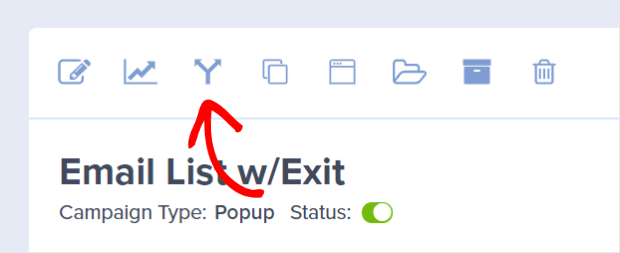
That way, you can play with the landing page copy, add videos, test different images, or make whatever small tweaks you think would improve your EPC.
From there, you can track which campaign is getting you the highest amount of sales and refine your landing pages accordingly.
For more information, check out this article on how to create a split test and why you should.
When it comes to emails, though, you’ll need to work with your email service provider. The ones we listed earlier (Drip, Constant Contact, and Brevo) all make A/B testing incredibly easy.
You can get accurate reports on your open and click-through rates to make smarter, data-driven decisions about your email campaigns.
And that brings us to our final tip to increase your earnings per click.
7. Calculate and Track Your Metrics
We’ve said it before, and we’ll say it again:
In the world of marketing, knowledge isn’t power. Knowledge is profit.
You need to keep track of the following metrics:
- EPC (yours, not the provided averages)
- CPC (yours, not the provided averages)
- A/B test results for your
- Affiliate landing pages
- Email campaigns
- Pay-per-click (PPC) ads
These 5 metrics will be the difference between you succeeding as an affiliate marketer or failing epically.
The first two metrics (EPC and CPC) can guide your marketing strategy.
With that information, you can make small adjustments to how you approach affiliate sharing to make sure you’re never spending more than you earn.
The last three metrics (involving A/B tests) will help you perfect your web copy.
Consequently, you can adjust how you communicate with your audience to get the best results. This will, ideally, lower CPC costs and increase your EPC, and drive more revenue.
And that’s all for now! These have been 7 concrete and actionable ways to increase your earnings per click:
We hope you enjoyed this post. If you did, you might want to check out the following resources:
- How to Make Money While You Sleep With Affiliate Marketing
- The Best WordPress Plugins for Affiliate Marketers
- Best Affiliate Marketing Tools for Every Marketer
- Affiliate Marketing Statistics All Marketers Must Know
- How to Use Social Media for Affiliate Marketing
These articles will have all the information you need to improve your affiliate marketing strategy, get higher earnings per click, and drive more profits.
FAQ
1. What does EPC stand for in affiliate marketing?
A. In affiliate marketing, EPC stands for “Earnings Per Click.” It is a metric used to measure the average earnings generated for every click on an affiliate link.

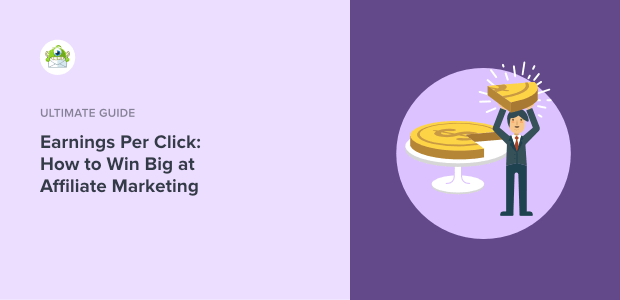








Add a Comment